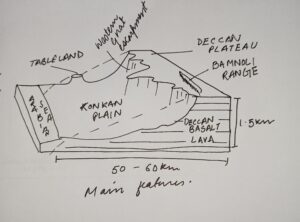Explain the geomorphological processes involved in the formation of the Deccan Plateau and how these processes have influenced its current landscape features. (Answer in 200 words)
Plate tectonics is a scientific theory proposed by Alfred Wegener in 1912 as the Continental Drift theory. This explains the mechanism of the evolution, nature, and motion of rigid and solid crustal layers of the earth, known as plates, which influence the geological process. These plates interact aRead more
Plate tectonics is a scientific theory proposed by Alfred Wegener in 1912 as the Continental Drift theory. This explains the mechanism of the evolution, nature, and motion of rigid and solid crustal layers of the earth, known as plates, which influence the geological process. These plates interact at boundaries—divergent, convergent, and transform—where significant geological activity occurs.
In the context of the Indian subcontinent, plate tectonics has played a vital role in shaping its diverse landforms like the Himalayan, Indo-Gangetic plain, western ghats, etc.
1. Himalayan Mountain The Himalayan mountain range is a folded mountain system shaped by the ongoing collision of the Indian and Eurasian lithospheric plates. This geological process began approximately millions of years ago during the Cretaceous period, when the Indian plate separated from Gondwana and began drifting northward. As the Indian plate moved towards the Eurasian plate, it began to sink below the Eurasian plate in the ancient Tethys Sea. This subduction led to the uplift of the sedimentary floor of the Tethys Sea due to giant pressure and sedimentation.
The northward movement of the Indian plate led to increasing both pressure and sedimentation. The Immense pressure and heat generated by this collision caused the lower layers of the Eurasian plate to melt, resulting in magma rising upwards. This molten material then solidified to form the parallel ranges of the Himalayan mountain chain.
Himalayan mountains are a direct consequence of the convergent boundary between the Indian and Eurasian plates, where the collision, subduction, and subsequent geological processes over millions of years have shaped this iconic fold mountain range.
2. During the upliftment of the Himalayan, a continuous collision between Indo and Eurasian plates resulted in trouble in the Himalayan and the formation of a deep synclinal depression between the Himalayas and the Indian peninsula.
Through this basin, rivers originating from the Himalayas, such as the Ganges, Brahmaputra, and their tributaries, carried lots of sediments due to precipitation and erosive forces of glaciation and deposited them into the basin over millions of years and this sedimentation gradually filled the depression. Which lead to the formation of the Great Gangetic Plain.
Tectonic interactions between the Indian and Eurasian Plates not only shaped the Himalayan ranges but also promoted the aggregation of fertile alluvial soils in the Gangetic plains.
3. Western Ghats continuous chain of blocked mountains. Western ghats were formed around 200 to 150 million years ago during the breakup of the supercontinent of Gondwana, during this Indian subcontinent separated from Gondwana supercontinent, At that time the southern part of now India was much larger. Around 100 to 80 million years ago due to plate tectonic movements rift valley was formed In the western part of this plateau and subducted in the Arabian Sea, the Eastern part of this rift rotated slightly and left the edge as a mountain named Western Ghats which is known as escarpment of India because of its stiff slope on the western side and gentle slope on east.
In summary, plate tectonics, as explained by Alfred Wegener’s theory of Continental Drift, has a significant impact on Earth’s geological features in the Indian subcontinent. The Indian and Eurasian Plates are continuously colliding, subducting, and moving, leading to the formation of the famous Himalayan mountains. This process has also contributed to the creation of the Great Gangetic Plain and the Western Ghats. These changes have occurred over millions of years, resulting in various landforms and rich soil deposits. This demonstrates how plate tectonics has greatly influenced the geography of the Indian subcontinent.
See less

Deccan Plateau - process involved and influence on the landscape Deccan Plateau was primarily shaped by the volcanic activity during the Late Cretaceous period, this period experienced extensive lava flows resulting in the formation. Now lets delve deeper into the formation of the deccan plateau ERead more
Deccan Plateau – process involved and influence on the landscape
Deccan Plateau was primarily shaped by the volcanic activity during the Late Cretaceous period, this period experienced extensive lava flows resulting in the formation.
Now lets delve deeper into the formation of the deccan plateau
Enormous volcanic explosions allow a large volume of basaltic lava to spread out over a vast area and harden into layers of basalt. The Deccan Traps were formed by these successive eruptions, producing the characteristics stepped terrains with flat-topped plateaus and deep valleys. The tectonic forces caused by the northward movement of the Indian Plate lifted up the Deccan Plateau. Additionally, India’s separation from Africa due to rifting and drifting of the Indian Plate also contributed to its formation.
The landscape has undergone significant changes over the ages due to weathering and erosion. Rivers such as Krishna and Godavari transport eroded material, creating deep valleys and gorges on the plateau hence contributing to the rough topography of the plateau.
Regur or black cotton soil is formed from the decay of basaltic rock rich in iron, which makes it good for farming. Therefore affecting land use patterns.
 Volcanic eruptions, tectonic uplifts as well as long term erosions are some of the factors that have shaped Deccan Plateau presently with its elevated terrain, deep river valleys and fertile soils.
Volcanic eruptions, tectonic uplifts as well as long term erosions are some of the factors that have shaped Deccan Plateau presently with its elevated terrain, deep river valleys and fertile soils.
See less